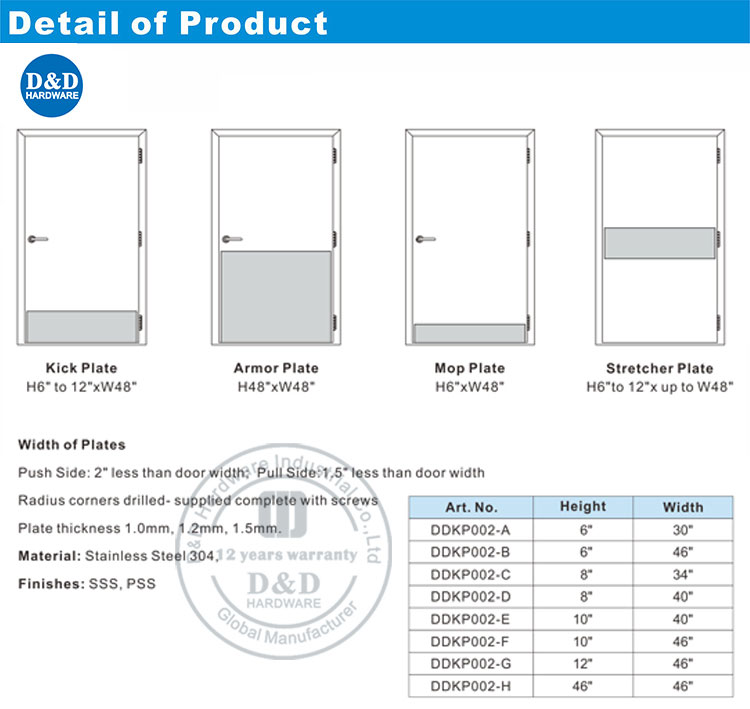Views: 0 Author: Site Editor Publish Time: 2024-06-03 Origin: Site

Stainless steel kickplates are essential components in both residential and commercial settings, designed to protect the lower portion of doors from damage caused by foot traffic, carts, or other impacts. These plates not only serve a functional purpose but also add an element of aesthetic appeal to doors.
The choice of material for kickplates is crucial, with stainless steel being a popular option due to its durability, resistance to corrosion, and sleek appearance. But one question that often arises is: how thick should a stainless steel kickplate be? Understanding the standard thicknesses available and their applications can help you make an informed decision.
When it comes to stainless steel kickplates, there isn't a one-size-fits-all answer regarding thickness. The standard thicknesses typically range from 0.8mm (approximately 1/32 inch) to 1.5mm (approximately 1/16 inch). Each thickness serves different purposes and offers varying levels of protection.
0.8mm (1/32 inch): This thinner option is suitable for light-duty applications where minimal impact protection is required. It provides adequate coverage while maintaining a low profile.
1mm (0.039 inch): A slightly thicker option that offers better durability without significantly increasing weight or bulkiness.
1.2mm (0.047 inch): Often considered the standard for most commercial applications, this thickness strikes a balance between strength and manageability.
1.5mm (1/16 inch): Ideal for heavy-duty environments where high impact resistance is necessary, such as industrial settings or areas with frequent cart traffic.
Several factors can influence your decision when selecting the appropriate thickness for your stainless steel kickplate:
Traffic Volume: High-traffic areas may require thicker plates to withstand constant use.
Type of Impact: Environments prone to heavy impacts or abrasive conditions will benefit from thicker plates.
Aesthetic Preferences: Thicker plates may offer a more robust look but could be less visually appealing in certain design contexts.
Selecting the right thickness for your stainless steel kickplate involves considering both practical needs and aesthetic preferences.
For residential use or light commercial settings like offices or retail stores, thinner options such as 0.8mm or 1mm might suffice. These provide adequate protection against scuffs and minor impacts without adding unnecessary weight or altering door aesthetics significantly.
In contrast, environments like hospitals, schools, warehouses, or industrial facilities demand more robust solutions due to higher traffic volumes and potential for more severe impacts. Here, opting for 1.2mm or even 1.5mm thick plates ensures longevity and effective protection against wear-and-tear over time.
Each thickness level brings its own set of advantages:
Thinner Plates (0.8mm – 1mm): Easier installation process; less noticeable; sufficient for low-impact areas; cost-effective solution.
Medium Plates (1 – 1.2 mm): Balanced approach offering good protection while remaining manageable in terms handling installation; versatile enough suit various applications.
Thicker Plates (1 .2 – 15 mm): Superior durability highest level impact resistance ideal demanding environments; longer lifespan reduced maintenance costs long term investment perspective!

In conclusion understanding how thick should stainless-steel kick plate be depends largely specific requirements context which they’ll used! By carefully evaluating factors such volume type impact along personal aesthetic preferences one can make informed decision ensuring optimal performance enhanced visual appeal any given setting!
D&D HARDWARE manufacture Door Hardware Accessories for hollow metal doors, wooden door and fire rated doors, with CE, UL, ANSI, BHMA certification, 3 hours fire rating, which will meet your local requirement. Products are suitable for education, healthcare, hotel, government, apartment building, hospitality and commercial applications.
Contact: David Jian
Mob: 0086-139 2903 7292
Email: David@dndhardware.com, sales@dndhardware.com
Jobby Zhang
Mob: 0086-137 2599 9617
Email: jobby@dndhardware.com